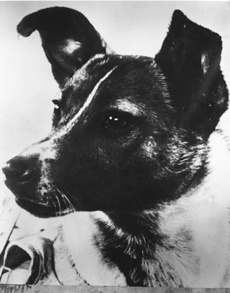World remembers USSR’s Laika, first dog in outer space
04 Nov 2017
On the evening of 3 November 1957, barely a month after the Soviet Union sent the world's first human-made satellite into orbit, a rocket lifted off from a secret site in Kazakhstan, carrying its second – this time with a live passenger on board.
 A week before the mission began, Moscow Radio had broadcast an interview with the cosmonaut in question, described as ''a small, shaggy dog''. It was a one-way ticket – Laika was never meant to return to earth.
A week before the mission began, Moscow Radio had broadcast an interview with the cosmonaut in question, described as ''a small, shaggy dog''. It was a one-way ticket – Laika was never meant to return to earth.
"I asked her to forgive us and I even cried as I stroked her for the last time," says 90-year-old Russian biologist Adilya Kotovskaya, recalling the day she bid farewell to her charge Laika.
The former street dog was about to make history as the first living creature to orbit the earth on a one-way journey.
The launch of Sputnik 2 was timed to coincide with the 40th anniversary of the October Revolution, and the craft itself was an appropriately showy statement of Communist know-how - six times heavier than Sputnik 1, designed to fly nearly twice as high, and, most impressive of all, containing a live passenger.
Western newspapers were initially confused about what to call her. Introduced as Kudryavka ('Little Curly'), she was also known as Limonchik ('Little Lemon') and Damka ('Little Lady'). A Soviet spokesman eventually clarified that her name was Laika ('Barker'), which did not to stop a columnist at Newsday from referring to her exclusively as ''Muttnik.''
Laika was far from the first dog to ride aboard a Russian rocket. Six years earlier, a pair of dogs named Dezik and Tsygan had reached the cusp of outer space, and since then more than two dozen others had followed.
In each case, the Soviets had chosen their test subjects from among Moscow's strays, on the theory that surviving on the lean streets of the capital was good preparation for the rigors of spaceflight.
The dogs had to be small, but not too small, and they had to have brightly coloured coats, so that they would show up on film. They also had to be female, to simplify the design of their suits.
As Asif Siddiqi recounts in his book Challenge to Apollo: The Soviet Union and the Space Race, 1945-1974', the stringency of the requirements prompted a local dog catcher to ask whether the animals needed ''to howl in C major,'' too.
The dog only lived for a few hours in space before succumbing to dehydration caused by the heat of the Sun, flying around the earth nine times. Nonetheless, "Those nine orbits of earth made Laika the world's first cosmonaut - sacrificed for the sake of the success of future space missions," says Kotovskaya, who remains proud of her pioneering work as a scientist training Laika and other early space animals.
For Soviet leader Nikita Khrushchev, Laika's voyage was yet another space feat to discomfit the Americans.
The USSR took an early lead in space exploration – it also sent the first human, Yuri Gagarin, into space – though the US eventually 'won' the space race by landing a man, Neil Armstrong, on the moon.
Sensing a PR opportunity, the Soviets paraded other rocket dogs before the press, allowing them to be photographed in their little space outfits.
But soon animal lovers chimed in on poor Laika's behalf. She was ''the shaggiest, lonesomest, saddest dog in all history,'' The New York Times's editorial board lamented; to subject her to such an experiment was ''monstrous'' and ''horrible''. An employee of an animal shelter noted Laika's inability to consent to the flight, calling it ''morally, spiritually, and ethically wrong''.
Early articles in the American press speculated that the Russians were likely to try to bring her back alive, and the director of the Moscow Institute of Astronomy seemed to confirm that this was true.
Ultimately, though, the Soviets admitted that Laika would never again set foot on earth. After a week in orbit, the Los Angeles Times reported, she would be fed poisoned food, ''in order to keep her from suffering a slow agony''.
When the moment came, Russian scientists reassured the public that Laika had been comfortable, if stressed, for much of her flight, that she had died painlessly, and that she had made invaluable contributions to space science.
Though much of the coverage of Sputnik 2 centered on Laika, she had very little to do with the mission's larger political message. Much as she amused contemporary commentators, they did not fail to realise that a missile powerful enough to put a satellite into orbit could also deliver a nuclear payload to any major American city.
While the military significance of 'Sput the First', as one newspaper dubbed it, could be poo-pooed - the satellite weighed only a 148 pounds, after all - the second Sputnik, larger and more advanced, was harder to ignore. It was not just the fact of it but the pace of it: as Russian satellites got bigger and better, the Americans were still struggling to build one of their own.
Edward Teller, the so-called father of the hydrogen bomb, warned that in a short time the USSR would have intercontinental ballistic missiles armed with nuclear warheads. But the Soviet advances also swayed American public opinion for a stronger space programme.






















